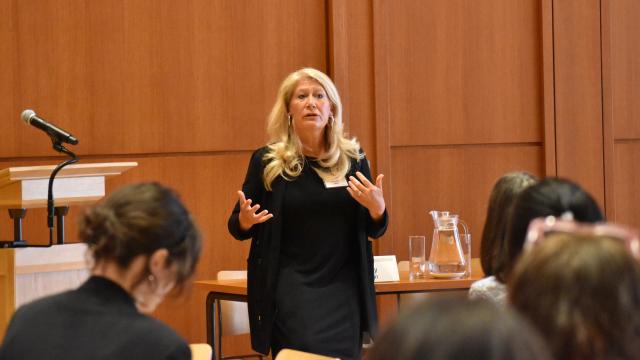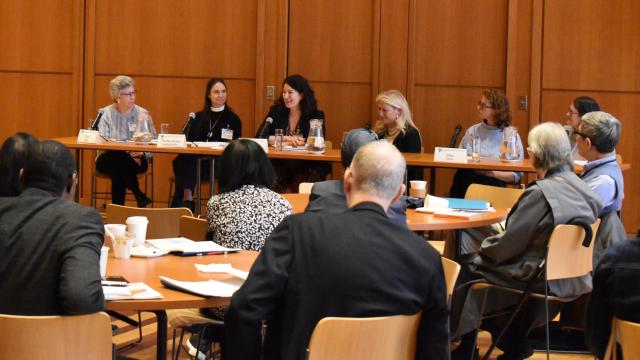Combatting the Diseases of Despair

On May 11, 2023—the same day the federal government declared an end to the COVID-19 public health emergency—Trinity Church Wall Street hosted its third symposium on mental health, “Intersections Between Spirituality and Mental Health.” Centering mental health has never been more important: over the past decades, public health professionals have documented a rise in “diseases of despair”: depression, anxiety, substance abuse disorders, and suicidal ideation. In just ten years, the percentage of adults with any mental health diagnosis has increased from 17.8% to 21%, with the largest shifts seen among adults ages 18–25, whose rates of mental illness were 1.65 times higher in 2020 than in 2011. The start of the COVID pandemic in 2020 drove much of this increase, but prevalence remains high.1
Just as the number of people experiencing these “diseases of despair” has risen, there has also been a decline in religious affiliation and spiritual practice. In the most recent Gallup poll on religious affiliation, the percentage of U.S. residents with no religious preference increased from 8% in 1998-2000 to 21% in 2018-2020; fewer than 50% were members of a congregation. This is the lowest level of religious participation since the survey was first conducted in 1937.2
The Consequences of a Public Square Without a Spiritual Core
The symposium keynote address by Dr. Lisa Miller, professor and founder of the Spirituality Mind Body Institute at Columbia University Teacher’s College, highlighted the importance of spirituality to mental well-being. Based on her research, Dr. Miller argued that a simultaneous loss of spiritual practice and poor mental health are not coincidental. Over the past four decades, religion and spirituality have been increasingly excluded from the “public square.” The quieting of spiritual expression—including and beyond formal religious traditions—makes it more difficult for people to (1) connect with their innate spirituality and (2) grow a shared spirituality.
The loss of spirituality and religious practice has enormous implications for how the brain functions. The human brain is, in fact, “hard-wired” for spirituality, which can then be nurtured through shared spiritual practice. When recognized and nurtured, spirituality supports healthy transitions through adolescence, middle age, and the end of life. These life stages are defined as “developmental depressions,” in which humans grapple with the questions:
- What is my purpose? (Adolescence)
- Have I lived up to my purpose? (Middle age)
- What is my spiritual footprint? (End of life)
When spirituality is not recognized and nurtured, individuals struggle through these milestones and are at greater risk of poor mental health. In one study, researchers found that among young adults—those most affected by a loss of spiritual “multilingualism”—the prevalence of moderate clinical depression was 48%. Clinical treatment remains important for mental health conditions, but our current epidemic of “diseases of despair” is also a cultural phenomenon. Simply put, the public square without a spiritual core is pathogenic.
Spiritual Growth, Support, and Repair
Following Dr. Miller’s keynote address, panel discussants shared how they engaged with clients, including those in psychotherapy, hospital patients, LGBTQ+ youth, and the street homeless. Among the diverse populations with which they work, spiritual abuse, trauma, and neglect are common. All participants reflected on the myriad ways they help people reconnect with their innate spirituality and use that touchpoint to grow a positive spiritual practice. Some examples our participants provided included:
- Encouraging a personal ritual or tradition to honor a loved one who has passed away
- Helping LGBTQ+ parishioners re-frame their view of and relationship with God
- Guiding patients toward a practice of gratitude for their recovery from illness
Most importantly, the panel participants reflected on the importance of listening and bearing witness as a means to affirm each person’s innate spiritual worth. Mental health, as one panelist noted, is a reflective process; tapping into one’s innate spirituality can provide the “breathing room” for such reflection.
What More Can We Do?
At the end of the symposium, attendees met in small groups to identify concrete steps they could take to improve spiritual and mental well-being in their communities. Some common themes emerged:
- Build connections with others, especially those in difficult circumstances. To do so, we need to examine our own fears and biases about those we view as different. How can we affirm the innate spiritual worth of all individuals?
- Offer opportunities to engage in rituals and sacred practices in both religious and non-religious settings. What can we do to “set the table” and bring meaning to our daily activities?
- Welcome people from all walks of life into religious spaces and bring religions and spirituality into other spaces. What makes people feel safe, welcome, and free from judgment?
These ideas represent a starting point for building our collective spiritual muscle, which is what supports us through developmental depressions and increases resilience. As Dr. Miller’s research attests, sharing spiritual life deepens our resilience even further. Indeed, nothing is more protective against diseases of despair than a shared spiritual life.
1 2020 National Survey on Drug Use and Health: Detailed Tables. Table 10.1B Any Mental Illness in Past Year: Among People Aged 18 or Older; by Demographic Characteristics, Percentages, 2008-2020. Available online at https://www.samhsa.gov/data/report/2020-nsduh-detailed-tables.
2 Jones JM. US church membership falls below majority for first time. Gallup, 29 Mar 2021. Available online at https://news.gallup.com/poll/341963/church-membership-falls-below-majority-first-time.aspx.

